by Tricia Diggins
In order to take a break from pulling invasive plants we finally started a program of sheet mulching in the Alexandra Botanic Gardens this past summer and fall.
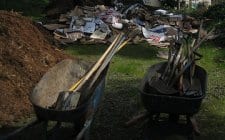 Sheet mulching is a method using several layers of mulching materials to improve soil and plant health and to kill or suppress unwanted plants. Our goal is to foster a healthy soil food web by making conditions favorable to increased biological activity in the soil while suppressing weeds so that mulching does not become more maintenance intensive than mowing grass. Increased biological activity in the soil will slowly improve soil compaction, make nutrients available to plants and possibly help mature trees live longer. Sheet mulching is also a great way for home owners to decrease the area of lawns in favor of garden beds and tree circles to create a more ecologically diverse landscape.
Sheet mulching is a method using several layers of mulching materials to improve soil and plant health and to kill or suppress unwanted plants. Our goal is to foster a healthy soil food web by making conditions favorable to increased biological activity in the soil while suppressing weeds so that mulching does not become more maintenance intensive than mowing grass. Increased biological activity in the soil will slowly improve soil compaction, make nutrients available to plants and possibly help mature trees live longer. Sheet mulching is also a great way for home owners to decrease the area of lawns in favor of garden beds and tree circles to create a more ecologically diverse landscape.
We are using three layers of mulch which initially makes this process labor and material intensive. This is one reason it has taken so long to switch from our previous practice of using one layer of wood chips around trees in tree circles. Another reason is that to be effective around mature trees the mulched area should be large enough to cover a decent percentage of the root system. Large mulched areas will change the look of the Botanic Gardens which have largely been a “tree lawn” or trees emerging from lawn or meadow. Large mulched areas are also a maintenance concern since tree circles have needed a lot of weeding and we do not use herbicides other than for poison ivy.
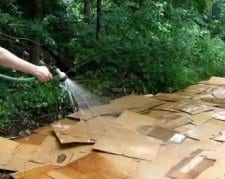 The method we have adopted is to first put a layer of wet cardboard on the ground where the grass or weeds have been cut short. Next we add a layer of an inch or two of compost bought from a supplier who provided soil food web test results showing it has a high fungal to bacteria ratio. We are trying to recreate a forest floor soil food web which is high in beneficial fungi or mycorrhizae. Mycorrhizae work with trees to increase water and nutrient uptake through the roots in return for carbohydrates manufactured by the tree through photosynthesis. So a compost made from carbon rich fungi food like wood chips or shredded oak leaves is desirable around trees. A compost made with a nitrogen source like manure mixed with a carbon source would be appropriate for non-woody plants like vegetables or perennials. Lastly we are adding a layer of wood chips, the less composted the better.
The method we have adopted is to first put a layer of wet cardboard on the ground where the grass or weeds have been cut short. Next we add a layer of an inch or two of compost bought from a supplier who provided soil food web test results showing it has a high fungal to bacteria ratio. We are trying to recreate a forest floor soil food web which is high in beneficial fungi or mycorrhizae. Mycorrhizae work with trees to increase water and nutrient uptake through the roots in return for carbohydrates manufactured by the tree through photosynthesis. So a compost made from carbon rich fungi food like wood chips or shredded oak leaves is desirable around trees. A compost made with a nitrogen source like manure mixed with a carbon source would be appropriate for non-woody plants like vegetables or perennials. Lastly we are adding a layer of wood chips, the less composted the better.
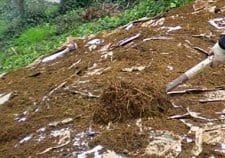 The cardboard acts as the initial weed barrier to kill the turf and as it decays it will help feed the fungi in the soil. I had heard that cardboard potentially contained toxic glues and was reluctant to use it on a large scale. But any concerns seem to be limited to cardboard from Asia. Given the amount of free cardboard available at Wellesley College there is the added benefit of using a resource generally regarded as waste to be trucked out for disposal or recycling. The compost layer adds organic matter to feed the existing food web as well as hopefully adding some of the organisms themselves. We currently buy the compost but it is not out of the realm of possibility that the college could someday generate the quality of compost we would like. The wood chips layer is more organic matter, additional weed protection (weed seeds will not germinate as easily in raw wood chips) and they create an aesthetic finish. The wood chips are also free and readily available. They are generated from the work of the campus arborists or outside tree companies. Once the area is sheet mulched maintenance should mainly be making sure colonies of weeds do not get established and adding wood chips to the bed as needed (or as time permits).
The cardboard acts as the initial weed barrier to kill the turf and as it decays it will help feed the fungi in the soil. I had heard that cardboard potentially contained toxic glues and was reluctant to use it on a large scale. But any concerns seem to be limited to cardboard from Asia. Given the amount of free cardboard available at Wellesley College there is the added benefit of using a resource generally regarded as waste to be trucked out for disposal or recycling. The compost layer adds organic matter to feed the existing food web as well as hopefully adding some of the organisms themselves. We currently buy the compost but it is not out of the realm of possibility that the college could someday generate the quality of compost we would like. The wood chips layer is more organic matter, additional weed protection (weed seeds will not germinate as easily in raw wood chips) and they create an aesthetic finish. The wood chips are also free and readily available. They are generated from the work of the campus arborists or outside tree companies. Once the area is sheet mulched maintenance should mainly be making sure colonies of weeds do not get established and adding wood chips to the bed as needed (or as time permits).
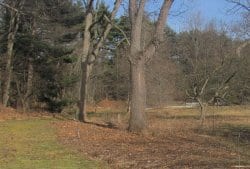 So far we have mulched one large area under a black walnut and a hickory and several tree circles under younger trees. Some Wellesley students are also sheet mulching to convert an overgrown ornamental garden behind the greenhouses to a vegetable garden. This brings up the point that sheet mulching is not new and can be used in many garden situations. I have adopted sheet mulching in my home garden in a big way.
So far we have mulched one large area under a black walnut and a hickory and several tree circles under younger trees. Some Wellesley students are also sheet mulching to convert an overgrown ornamental garden behind the greenhouses to a vegetable garden. This brings up the point that sheet mulching is not new and can be used in many garden situations. I have adopted sheet mulching in my home garden in a big way.
Growing up, my father had a copy of one of Ruth Stout’s books on Gardening without Work, but I never picked it up. Ruth Stout was an advocate of using many layers of mulch, or lasagna gardening, to improve soils and save work by not digging or tilling. To most gardeners establishing a new garden bed or the yearly planting of a vegetable garden involves rototilling or turning the soil with a fork. Solarizing the soils with black or clear plastic to kill weeds is also considered an option, but it can take up to a season and the results are inconsistent. To create a new garden bed I used to turn the turf over with a fork and allow it to decompose, but I was always pulling the grass that didn’t get buried enough and the soil was not improved until I haphazardly incorporated compost. Now I put down cardboard, compost I make at home, and a top layer of straw. This gets rid of the turf and the bed can be planted fairly soon (within a month during the growing season if the cardboard stays wet). Best of all the soil food web stays intact and the mulch feeds it. Rototilling (and digging to some extent) breaks up the soil food web which then cannot do the jobs of helping plants take up water and nutrients and of suppressing weeds, insect and diseases. The continual disturbance of the soil food web by tilling creates an early successional stage ecology which is most conducive to growing annual weeds and requires more input of nutrients and more pest control.
There are a few of caveats of which to be aware. Sheet mulching to get rid of lawn is successful any time of year but perennial weeds like poke weed are more difficult. I have not had direct experience with this but I would put down several layers of cardboard instead of one and Dave Jacke, the author of Edible Forest Gardens says mulch in the spring, never the fall, to get rid of tougher weeds. Recommendations on the depth of mulch to create beds vary and it can be somewhat arbitrary but when mulching young trees and even middle aged trees it is important to limit the mulch depth to 2-4” with no mulch within 4-6” of the trunk. Young trees will send roots into the mulching material rather than the soil if the mulch is too deep leading to too many roots at the surface subject to faster drying out and less stability in wind. Trees with mulch right at the trunk are more likely to develop girdling roots that can partially grow around or into the trunk strangling the tree and making it more likely to break off in a storm. Mulch also sometimes attracts the wrong kind of diversity in the form of rodents, slugs and snails. I have not had a problem that was worsened by mulch but it is always good to protect the bark of young trees with a rodent guard especially in the winter.
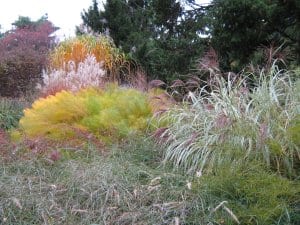 In the Botanic Gardens we are re-thinking lawns. Already we are converting most turf areas to less frequently mowed meadows. Lawns can be managed in an environmentally friendly way and the need for open spaces for playing or other gatherings means they have a place in the landscape. But converting lawn to meadow, forest or food growing does much more for the environment by increasing diversity in the local plants, animals and the soil food web. To be ultimately sustainable all material used in mulching should be generated on site but making the soil healthy needs to happen first. Sheet mulching is an important tool for improving the soil and in transitioning to more sustainable landscaping.
In the Botanic Gardens we are re-thinking lawns. Already we are converting most turf areas to less frequently mowed meadows. Lawns can be managed in an environmentally friendly way and the need for open spaces for playing or other gatherings means they have a place in the landscape. But converting lawn to meadow, forest or food growing does much more for the environment by increasing diversity in the local plants, animals and the soil food web. To be ultimately sustainable all material used in mulching should be generated on site but making the soil healthy needs to happen first. Sheet mulching is an important tool for improving the soil and in transitioning to more sustainable landscaping.
About the Author
Tricia Diggins is the Senior Gardens Horticulturalist at Wellesley College where she has taken care of the Arboretum/ Botanic Garden for nearly 20 years. She began her horticulture career as an intern at New England Wildflower Society’s Garden in the Woods in 1990 several years after earning a B.S. in Environmental Sciences at UMass Amherst. When Tricia isn’t caring for the plants at Wellesley College, she is developing and maintaining a third of an acre edible landscape.
Wellesley College Botanic Garden/Wellesley College Friends of Horticulture (Copyright 2009) Reprinted With Permission
Mulch spreading photo by Karla Nagy Johnson (San Francisco community sheet mulching project.) http://sanfranciscosidewalks.wordpress.com/
Equipment and watering photos by Kathleen Maier http://www.sacredplanttraditions.com/

